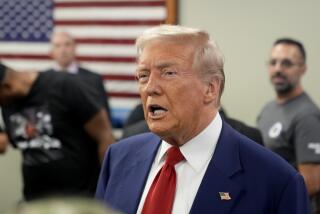Obama machine preps for long haul
WASHINGTON — As Barack Obama builds his administration and prepares to take office next week, his political team is quietly planning for a nationwide hiring binge that would marshal an army of full-time organizers to press the new president’s agenda and lay the foundation for his reelection.
The organization, known internally as “Barack Obama 2.0,” is being designed to sustain a grass-roots network of millions that was mobilized last year to elect Obama and now is widely considered the country’s most potent political machine.
Organizers and even Republicans say the scope of this permanent campaign structure is unprecedented for a president. People familiar with the plan say Obama’s team would use the network in part to pressure lawmakers -- particularly wavering Democrats -- to help him pass complex legislation on the economy, healthcare and energy.
The plan could prompt tensions with members of Congress, who are unlikely to welcome the idea of Obama’s political network targeting them from within their own districts. Already, Democratic Party officials on the state level worry that it could become a competing political force that revolves around the president’s ambitions while diminishing the needs of down-ballot Democrats.
Though the plan still is emerging, one source with knowledge of the internal discussion said the organization could have an annual budget of $75 million in privately raised funds. Another said it would deploy hundreds of paid staff members -- possibly one for every congressional district in certain politically important states and even more in larger battlegrounds such as Florida, Ohio, Colorado, Virginia and North Carolina.
The full-time staff is likely to consist primarily of the presidential campaign workers, many in their 20s, who served as the local points of contact for the campaign’s vast network of neighborhood volunteers. As part of the new organization, these workers probably would focus on similar campaign-style tasks, such as arranging phone banks, distributing signs, recruiting more helpers, buying coffee and doughnuts for house meetings and reporting voter contact data to senior officials.
“The only way to keep this thing going is to have boots on the ground,” said a strategist familiar with the plan who spoke on condition of anonymity because campaign officials have not granted permission to talk about it.
In what would be another unprecedented step, Obama’s political staff is deciding whether to create a service organization that would use the vast corps of its grass-roots campaign supporters. As described by one source knowledgeable with the discussions, this nonprofit arm would be used to help victims of natural disasters, but would do so under the Obama umbrella while continuing to build the overall network’s massive e-mail database.
The prospect of a president being able to guide a service or relief agency outside the framework of his government is a unique development.
Though the campaign-style organizing network would be operated through the Democratic National Committee, the new service organization is envisioned as a separate nonprofit. Obama recently appointed his friend Gov. Tim Kaine of Virginia as chairman of the DNC and his campaign battleground states director, Jennifer O’Malley Dillon, as executive director.
Some top Obama organizers, such as former deputy campaign manager Steve Hildebrand, had argued that the grass-roots machinery should be kept separate from the DNC to avoid alienating Republicans and independents who were inspired by Obama but could be turned off by a close association with the Democratic Party. But those organizers are not part of the inner circle drafting the plan.
A centralized system run from the DNC would mark a break from the Democratic tradition of relying more on muscular state and local party organizations. It would more closely mirror the Republican structure created under President Bush, whose political guru Karl Rove engineered the 2004 reelection campaign from his post at the White House using a central GOP database.
One key difference, however, is that the Republicans used their network to target Democrats and win elections, whereas the Obama system will be used at least in part to influence members of the president’s own party.
For example, Democratic lawmakers in Republican-leaning districts might resist voting for an Obama-backed global warming bill. In that case, the White House or DNC could use the new network for phone campaigns, demonstrations or lobbying trips to push lawmakers to stick with Obama.
“You can pretty much target the list to people who haven’t always voted with Democrats,” said a House Democratic leadership aide familiar with the plan.
This aide said the pressure could actually help Democrats in those districts. They could either point to a groundswell of support for the Obama policy as a reason to vote for it -- or, alternatively, they could choose to score points with conservatives by bucking the activists.
“It could give them cover either way,” the aide said.
Another Capitol Hill strategist, however, said some lawmakers in closely contested districts were anxious about the Obama plan, “watching very carefully to see whether or not they’re going to be pressured at home.”
A spokesman for the Obama campaign, Ben LaBolt, declined to comment other than to say that any speculation about budget figures, state-specific strategy or staffing levels was premature because the plan had not been finalized.
Strategists in both parties said the ideas being discussed would create an on-the-ground weapon for policy battles far more powerful than the speeches, news conferences and donor-targeting techniques traditionally used by presidents.
“No one’s ever had these kinds of resources,” said Republican strategist Ed Rollins, who led political operations under President Reagan. “This would be the greatest political organization ever put together, if it works.”
In operating the network, the DNC would work closely with the White House political office, which will be headed by experienced campaign organizers schooled in the Obama tactics of using the Internet to harness the massive network of neighborhood-level volunteers.
Obama’s presidential campaign generated a database of 13 million e-mail addresses and tens of thousands of phone bank volunteers and neighborhood coordinators. Strategists believe these assets can grow in the years before Obama runs again.
Concerns about Obama’s ambitions are coming from state party leaders as well as from Capitol Hill.
“The party needs to be rooted not just around one individual, but it needs to have a grass-roots base that can survive the times and even endure past whoever may be in office,” said Jerry Meek, chairman of the North Carolina Democratic Party. “Obama brings a lot to the table, but, on the other hand, state parties exist for more than serving the objectives of the president and are in the business to elect county commissioners, school board members and members of the legislature.”
--
More to Read
Get the L.A. Times Politics newsletter
Deeply reported insights into legislation, politics and policy from Sacramento, Washington and beyond. In your inbox three times per week.
You may occasionally receive promotional content from the Los Angeles Times.








